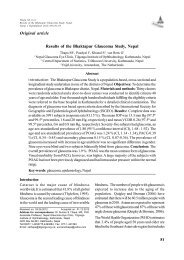nepjoph 2012.pmd - Nepalese Journal of Ophthalmology
nepjoph 2012.pmd - Nepalese Journal of Ophthalmology
nepjoph 2012.pmd - Nepalese Journal of Ophthalmology
Create successful ePaper yourself
Turn your PDF publications into a flip-book with our unique Google optimized e-Paper software.
Ganekal S<br />
Ganglion cell complex scan<br />
Nepal J Ophthalmol 2012;4(8):236-241<br />
cell layer (GCL) which is made up <strong>of</strong> the ganglion<br />
cell bodies, and 3) the inner-plexiform layer (IPL)<br />
which is made up <strong>of</strong> the ganglion cell dendrites. All<br />
three layers are collectively known as the ganglion<br />
cell complex (GCC) (Fig 1). Fourier Domain OCT<br />
can measure the thickness <strong>of</strong> the macular GCC,<br />
which extends from the internal limiting membrane<br />
to the inner nuclear layer including the ganglion cell<br />
layer and provides a unique analysis <strong>of</strong> the percent<br />
loss <strong>of</strong> these layers compared to an extensive<br />
normative database.<br />
Glaucoma is characterized by the selective loss <strong>of</strong><br />
retinal ganglion cells (RGC) (Garway-Heath DF et<br />
al 2000: Harwerth RS et al 1999: Zeimer R et al<br />
1998). Because the macular region contains more<br />
than 50% <strong>of</strong> all the RGCs, assessing ganglion cell<br />
changes in the macular region may be more useful<br />
in diagnosing glaucoma than measuring peripapillary<br />
RNFL thickness (Ishikawa H et al 2005, Tan O et<br />
al 2008: Van Buren JM 1963). RTVue-100<br />
(Optovue, Fremont, California) is a commercially<br />
available OCT device with Fourier-domain (FD)<br />
technology.<br />
Although previous studies have shown the utility <strong>of</strong><br />
peripapillary RNFL measurements in glaucoma<br />
patients, little is known about the comparison<br />
between RNFL thickness and macular GCC or the<br />
diagnostic ability <strong>of</strong> GCC using FD-OCT. In this<br />
study, we used FD-OCT to compare macular GCC<br />
and peripapillary RNFL thickness to aid in the early<br />
diagnosis <strong>of</strong> glaucoma.<br />
Materials and methods<br />
Forty participants [n=20 glaucoma suspects (GS;<br />
normal SAP, C/D ratio <strong>of</strong> more than 0.5 or<br />
asymmetry <strong>of</strong> more than 0.2 and/or ocular<br />
hypertension) and n=20 glaucoma patients (MD <strong>of</strong><br />
less -12 dB, glaucomatous optic neuropathy)] were<br />
enrolled. The study was approved by our institutional<br />
review board (IRB) and complied with the tenets<br />
<strong>of</strong> the Declaration <strong>of</strong> Helsinki. Informed consent<br />
was obtained from all participants.<br />
All eyes underwent applanation tonometry, dark<br />
room gonioscopy, stereoscopic optic disc<br />
photography, red-free RNFL photography and<br />
RTVue FD-OCT after pupillary dilation to a<br />
minimum diameter <strong>of</strong> 5 mm on the same day.<br />
Peripapillary RNFL and perifoveal GCC thickness<br />
measurements were obtained using RTVue-100 by<br />
the same operator in the same visit. Standard<br />
Automated Perimetry was performed with the<br />
Octopus 3.1.1 Dynamic 24-2 program.<br />
OCT measurements<br />
The average thickness <strong>of</strong> the GCC and RNFL was<br />
measured using RTVue-100 (s<strong>of</strong>tware version:<br />
4.0.5.39), which acquires 26,000 A scans per<br />
second and has a 5 ìm depth resolution in tissue.<br />
The RNFL thickness was determined by the nerve<br />
head map 4 mm diameter (NHM4) mode, which<br />
measures RNFL thickness by recalculating data<br />
along a 3.45 mm diameter circle around the optic<br />
disc using a map created from en face imaging<br />
utilizing six circular scans ranging from 2.5 to 4.0 mm<br />
in diameter (587 or 775 A scans each) and 12 linear<br />
data inputs (3.4 mm length, 452 A scans each). Disc<br />
area measurements were also obtained using the<br />
NHM4 mode.<br />
GCC parameters were obtained by the MM7<br />
protocols, centered 1 mm temporal to the fovea.<br />
This protocol uses one horizontal line with a 7 mm<br />
scan length (934 A scans) followed by 15 vertical<br />
lines with a 7 mm scan length and 0.5 mm interval<br />
(800 A scans)(Fig 2A). The GCC thickness was<br />
measured from the internal limiting membrane to the<br />
inner plexiform layer boundary. The focal loss<br />
volume (FLV) as the integral <strong>of</strong> deviation in areas<br />
<strong>of</strong> significant focal GCC loss and global loss volume<br />
(GLV) as the sum <strong>of</strong> negative fractional deviation in<br />
the entire area were also computed. Images with a<br />
Signal Strength Index less than 35 with overt<br />
misalignment <strong>of</strong> the surface detection algorithm or<br />
with overt decentration <strong>of</strong> the measurement circle<br />
location were excluded.<br />
RNFL and GCC thicknesses in the normal range<br />
were represented by green backgrounds, those that<br />
were abnormal at the 5% level were represented<br />
by yellow backgrounds, and those that were<br />
237




